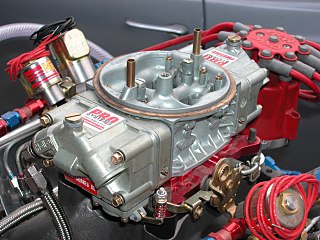
A carburetor is a device used by an internal combustion engine to control and mix air and fuel entering the engine. The primary method of adding fuel to the intake air is through the Venturi tube in the main metering circuit, though various other components are also used to provide extra fuel or air in specific circumstances.
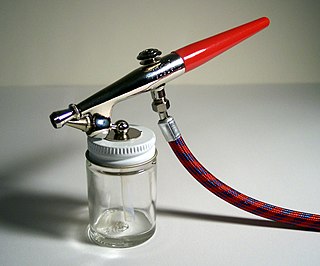
An airbrush is a small, air-operated tool that atomizes and sprays various media, most often paint but also ink and dye, and foundation. Spray painting developed from the airbrush and is considered to employ a type of airbrush.
A water gun is a type of toy gun designed to shoot jets of water. Similar to water balloons, the primary purpose of the toy is to soak another person in a recreational game such as water fight.
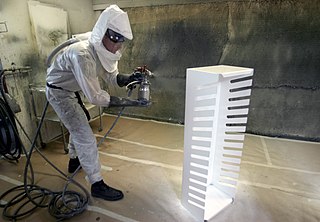
Spray painting is a painting technique in which a device sprays coating material through the air onto a surface. The most common types employ compressed gas—usually air—to atomize and direct the paint particles.
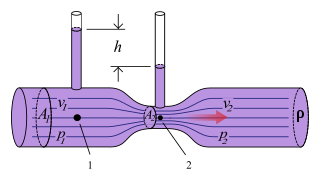
The Venturi effect is the reduction in fluid pressure that results when a fluid flows through a constricted section of a pipe. The Venturi effect is named after its discoverer, the 18th-century Italian physicist Giovanni Battista Venturi.

In medicine, a nebulizer or nebuliser is a drug delivery device used to administer medication in the form of a mist inhaled into the lungs. Nebulizers are commonly used for the treatment of asthma, cystic fibrosis, COPD and other respiratory diseases or disorders. They use oxygen, compressed air or ultrasonic power to break up solutions and suspensions into small aerosol droplets that are inhaled from the mouthpiece of the device. An aerosol is a mixture of gas and solid or liquid particles.

Air fresheners are consumer products that typically emit fragrance and are used in homes or commercial interiors such as restrooms, foyers, hallways, vestibules and other smaller indoor areas, as well as larger areas such as hotel lobbies, auto dealerships, medical facilities, public arenas and other large interior spaces. Car fresheners are used in automobiles. As a source of odors, specific deodorizing blocks are made for toilets and urinals.

FLIT is the brand name for an insecticide. The original product, invented by chemist Dr. Franklin C. Nelson and launched in 1923 and mainly intended for killing flies and mosquitoes, was mineral oil based and manufactured by the Standard Oil Company of New Jersey before the company, now part of ExxonMobil, was renamed first Esso and later Exxon. The Esso formulation contained 5% DDT in the late 1940s and early 1950s, before the negative environmental impact of DDT was widely understood. Later marketed as "FLIT MLO", it has since been discontinued. A hand-operated atomizer called a Flit gun was commonly used to perform the spraying.

Haze machines, or haze generators, are effects machines similar to fog machines, designed to produce an unobtrusive, homogeneous clouds suspended in the air intended primarily to make light beams visible or create a subtle diffusion.

A spray bottle is a bottle that can squirt, spray or mist fluids.

An oil burner is a heating device which burns #1, #2 and #6 heating oils, diesel fuel or other similar fuels. In the United States ultra low #2 diesel is the common fuel used. It is dyed red to show that it is road-tax exempt. In most markets of the United States heating oil is the same specification of fuel as on-road un-dyed diesel.

A sprayer is a device used to spray a liquid, where sprayers are commonly used for projection of water, weed killers, crop performance materials, pest maintenance chemicals, as well as manufacturing and production line ingredients. In agriculture, a sprayer is a piece of equipment that is used to apply herbicides, pesticides, and fertilizers on agricultural crops. Sprayers range in size from man-portable units to trailed sprayers that are connected to a tractor, to self-propelled units similar to tractors with boom mounts of 4–30 feet (1.2–9.1 m) up to 60–151 feet (18–46 m) in length depending on engineering design for tractor and land size.
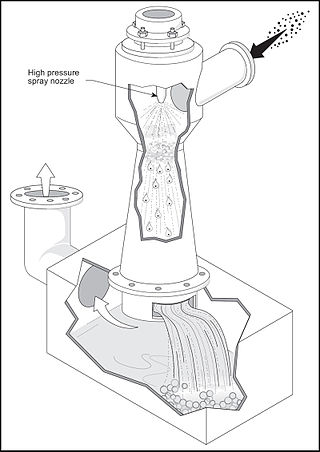
A venturi scrubber is designed to effectively use the energy from a high-velocity inlet gas stream to atomize the liquid being used to scrub the gas stream. This type of technology is a part of the group of air pollution controls collectively referred to as wet scrubbers.

A spray nozzle or atomizer is a device that facilitates the dispersion of a liquid by the formation of a spray. The production of a spray requires the fragmentation of liquid structures, such as liquid sheets or ligaments, into droplets, often by using kinetic energy to overcome the cost of creating additional surface area. A wide variety of spray nozzles exist, that make use of one or multiple liquid breakup mechanisms, which can be divided into three categories: liquid sheet breakup, jets and capillary waves. Spray nozzles are of great importance for many applications, where the spray nozzle is designed to have the right spray characteristics.

Pesticide application refers to the practical way in which pesticides are delivered to their biological targets. Public concern about the use of pesticides has highlighted the need to make this process as efficient as possible, in order to minimise their release into the environment and human exposure. The practice of pest management by the rational application of pesticides is supremely multi-disciplinary, combining many aspects of biology and chemistry with: agronomy, engineering, meteorology, socio-economics and public health, together with newer disciplines such as biotechnology and information science.
Ultra-low volume (ULV) application of pesticides has been defined as spraying at a Volume Application Rate (VAR) of less than 5 L/ha for field crops or less than 50 L/ha for tree/bush crops. VARs of 0.25 – 2 L/ha are typical for aerial ULV application to forest or migratory pests.

Ultrasonic nozzles are a type of spray nozzle that use high frequency vibrations produced by piezoelectric transducers acting upon the nozzle tip that create capillary waves in a liquid film. Once the amplitude of the capillary waves reaches a critical height, they become too tall to support themselves and tiny droplets fall off the tip of each wave resulting in atomization.
Plaster spraying allows a plasterer to skim a drywall more than five times faster than using a hand float to apply it. Although classic gypsum-based plaster can be sprayed if it is "spray grade," most plaster sprayers prefer the organic-based pre-mixed plaster packaged in a plastic bag because the plaster spraying machine does not need to be cleaned out after the job is finished, providing that plaster is kept moist. The pre-mixed plaster also has the advantage that any surplus can be recycled, almost eliminating waste, and plasterers do not need to haul water and mix the plaster from powder. A drywall skimmed with pre-mixed plaster can be painted in less than 24 hours, depending on the ambient temperature and humidity.

A spray is a dynamic collection of drops dispersed in a gas. The process of forming a spray is known as atomization. A spray nozzle is the device used to generate a spray. The two main uses of sprays are to distribute material over a cross-section and to generate liquid surface area. There are thousands of applications in which sprays allow material to be used most efficiently. The spray characteristics required must be understood in order to select the most appropriate technology, optimal device and size.
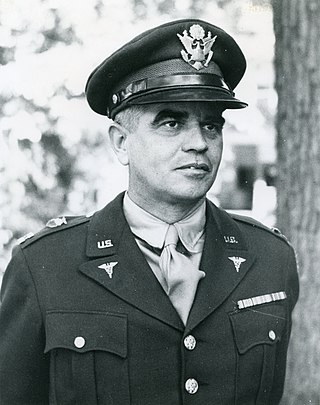
William N. Sullivan was an American entomologist who is widely credited with co-inventing the aerosol bomb or "bug bomb," with Lyle D. Goodhue, while employed by the United States Department of Agriculture. The "bug bomb" was developed for aircraft disinsection through the dispersion of insecticide for controlling mosquitoes. The invention proved invaluable in the Pacific Theater during World War II where it was used extensively to control the spread of insect borne disease - primarily malaria - which was causing far more casualties than actual combat.
















